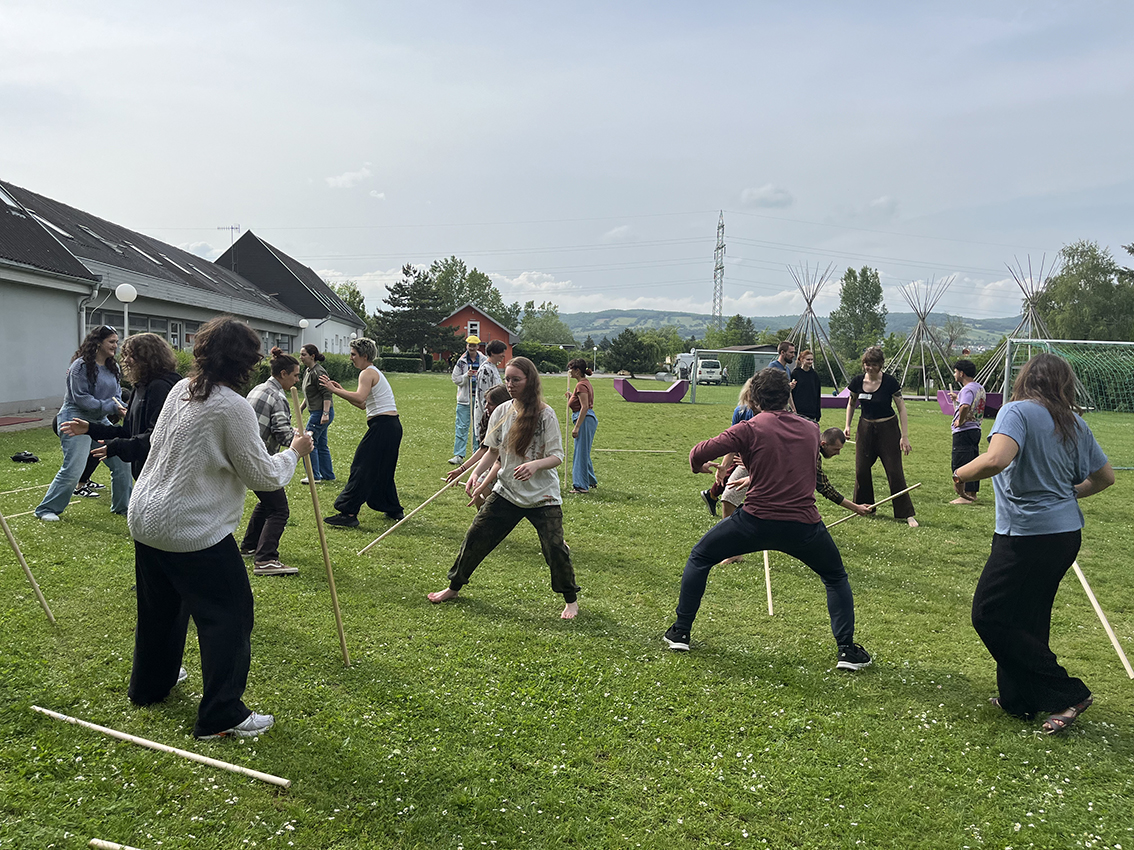The Game of Sticks
Download the methods
To download the methods, click here
Target group
No. of pax
Environment
Time needed
Materials
One smooth stick (at least 1.2 m long) per participant
Objective/aim
• Practise distinguishing yourself from your character through embodied role-play.
• Develop agility, presence and focused attention.
• Explore physical thresholds and transitions (inspired by Michael Chekhov’s technique)
Step by step instructions
Step 1
Setup
3 min
• Create a circle using the sticks, with ends touching.
• Participants stand around the outside, one step away, facing inwards.
Step 2
Explain the Game of Sticks
1 minute
Use a live demonstration with a participant.
Basic rules:
• Two players stand one stick-length apart.
• Hold the stick vertically between them, one end touching the ground.
• One player tilts and pushes the stick to the other, who catches it before it falls and returns it.
• Keep one end of the stick on the ground at all times.
• Increase speed or change direction suddenly to make it more challenging.
• If the stick drops, the other player scores a point.
• Keep this explanation under one minute. You may demonstrate again once players are in character.
Step 3
Crossing the Threshold – Entering Role
2-5 minutes
Explain that the circle represents a threshold from your daily self into a character. First role: A child.
Transition Ritual:
• Step forward and place a hand inside the circle. Imagine it is the hand of a child.
• Take the hand back – it becomes your ordinary hand again. Then repeat with your foot, then your head – one at a time.
• When ready, step fully into the circle and take your first breath “as a child.”
• Pick up a stick and find a partner.
Step 4
The Game (in role)
3-8 minutes
Participants play the Game of Sticks while staying in character.
Introduce variations (e.g. touch the stick only with your head, feet, or back). Switch partners once or twice.
Step 5
Return
3-5 minutes
Participants say goodbye to their partner, find a personal space and place their stick flat on the ground.
When ready, step back over the threshold and return to your everyday self.
Rebuild the circle with the sticks.
Step 6
New Rounds
(circa 8 minutes each)
Repeat with different roles: e.g. activist, athlete, politician, teacher…
Each role begins with the same threshold ritual.
Step 7
Group Discussion
10 minutes
Use questions:
• “What changed in your attitude toward the game in each role?”
• “What shifted in how you interacted with partners?”
• “What did the threshold mean to you?”
Leave space for emotional reflection.
Tips for the trainer
This game is very open ended – adapt the roles to suit the purpose of your training.
During the game step, the level of prompting needed to keep participants in character may vary. Some may need constant reminders to remain in character. Avoid using judgmental language; instead, use neutral phrases like, ‘Let’s connect with our inner child’ or ‘Let’s stay in our child role.
This game requires agility and activity – it works best after a warm-up.
You can also explain the rules while participants are already in role. However, the child role can make it challenging to concentrate on instructions at the same time.
Alternative
If there is an uneven number of participants – you can participate yourself or ask one pair to form a group of three instead.
For people with alternative motorics – the game itself is a secondary objective of the activity. You can exchange it to any other activity that lies within your group’s capabilities. The threshold itself can be hanging over the participant (e.g. to not obstruct the movement) or be made of fabric.
Comment
Source
The exercise is the mixture of classic physical theatre and circus exercises with a stick and “crossing the threshold” practice from Michael Chekhov. It was developed for the purposes of the My Elections – My EU! project by Adam Banach.


